Special, different and unique. With these words, we can describe the new Japanese sub compact crossover SUV, Toyota C-HR. A confident statement is based on what C-HR offers. And it really offers a lot: very good performance, unique design, and the latest hybrid technology, taken from the EV legend itself, the Prius.
Do you know what C-HR stands for? Coupe High-Rider.
Toyota is a pioneer among hybrid vehicles (Prius) and sports SUVs (RAV4). But until now, in SUV C-class, which is the fastest growing vehicle class in Europe, they didn’t have a representative of their own.
2016 Toyota C-HR exterior: free creativity

2016 Toyota C-HR exterior creativity: coupe on top, SUV on the bottom.
The story of the external design is divided into two parts, on the lower and upper part. The upper part wants to be a coupe with the falling roof, spoiler, typical slanted windows and high waistline. The lower part is from the SUV world. Strong, with large wheels and expressed wheel arches and a higher distance from the ground in comparison with conventional hatchbacks.
New Toyota C-HR is a car that exudes a desire to be different. As far as the exterior is concerned, they wanted to emphasize the freedom and engineering creativity. Toyota C-HR is 4.36 meters long, 1.79 meters wide and has a 2.64-meter long wheelbase. It is the result of a new Toyota New Global Architecture (TNGA) platform, currently shared only with the latest generation Prius.
Striking exterior is a big plus in the battle for market share
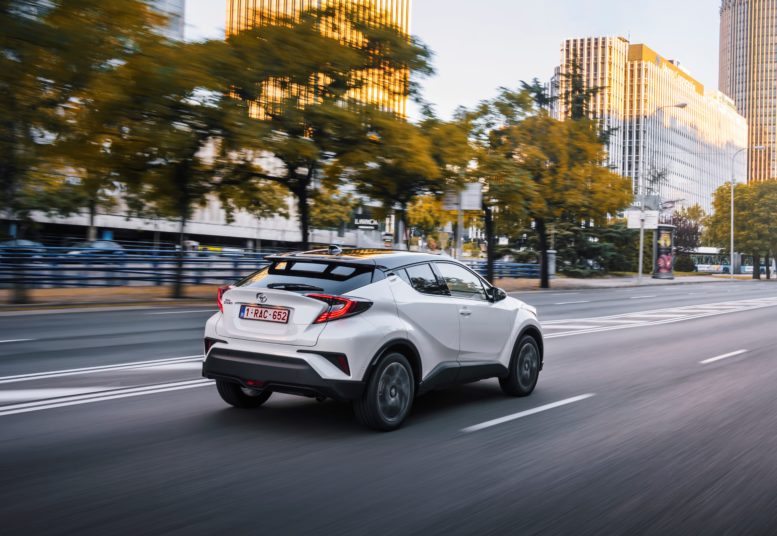
2016 Toyota C-HR design plays on the human emotions Violine.
Toyota C-HR will have to compete with the high standards and rivals in its vehicle segment, especially in the European market. And one of the aces is definitely a card that plays on the drivers’ emotions. Just look at the exterior design.
We definitely have to congratulate Toyota for courage. The exterior lines are quite bold. In our opinion, Toyota C-HR went even further than Nissan Juke. Of course, not everyone will like it, but some mysterious attraction is certainly present.
Seen on the road, new Toyota C-HR raises interest among old and young, people are taking out the phones and pressing the photo button. This is a sign that boldness has a potential.
Small details make Toyota C-HR even more interesting
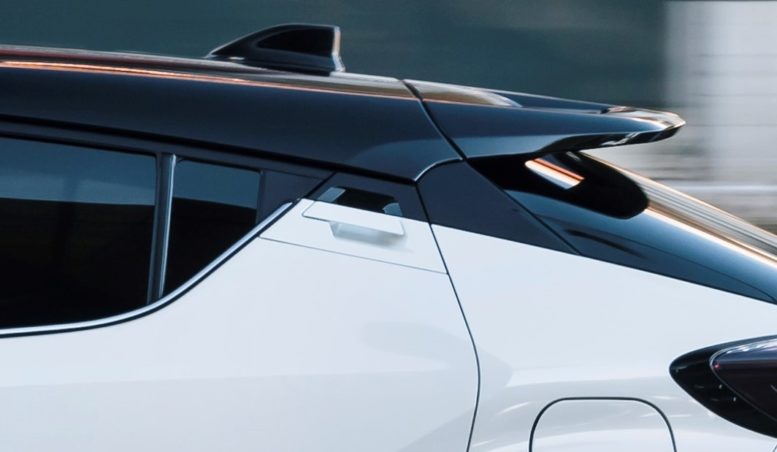
2016 Toyota C-HR rear door handle
Toyota C-HR is full of interesting details and the rear door handle, integrated high into the doors and window, is undoubtedly the most important one, giving the Toyota C-HR an image of a 2-door coupe instead of a 5-door crossover SUV.
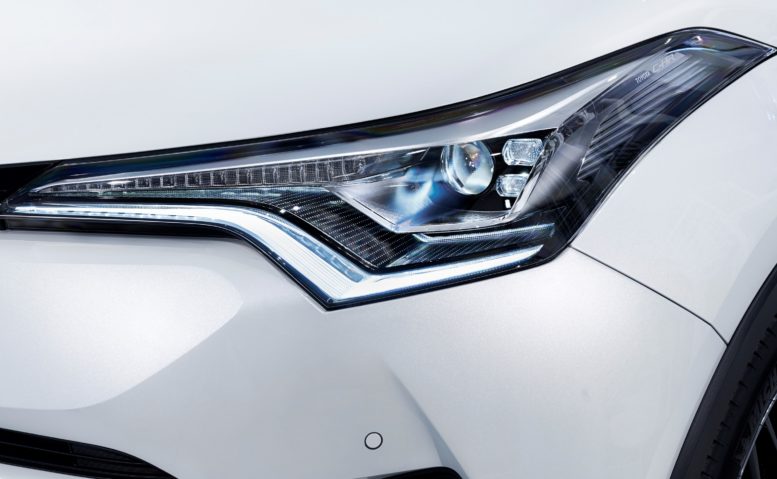
2016 Toyota C-HR full LED headlights
Headlights in full LED technology are probably the longest of all, reaching almost to the windshield. For the first time, Toyota offered dynamic LED direction indicators, which contribute to the premium impression. Rear LED strips are in the shape of a boomerang. Under mirrors we found laser sensors projecting the logo and the C-HR inscription to the ground.
Inside the cabin: modern and simple
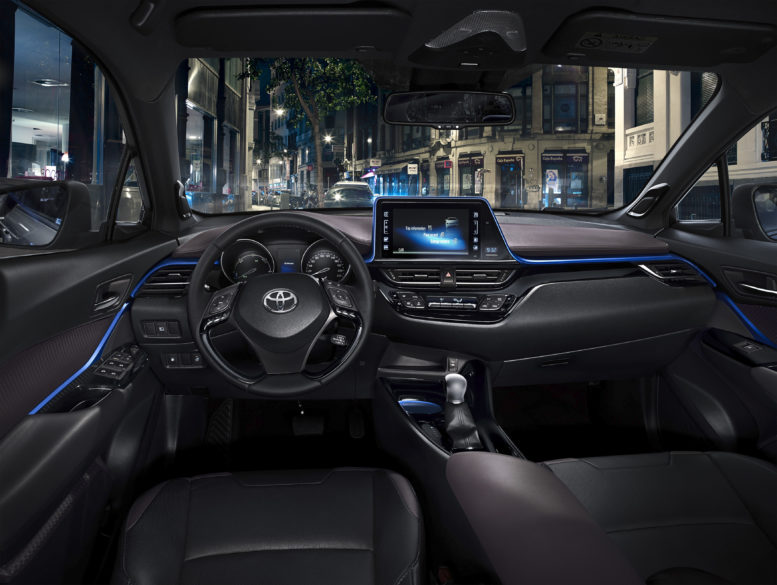
2016 Toyota C-HR dashboard
The cabin is primarily intended for the driver. The dashboard turned slightly towards the side of the car where the steering wheel is located, only confirms that. Everything is at your fingertips, the distance between different gears on a gearbox is a little too long for sports driving, but also very accurate.
The driving position is good and understandably high. The feeling in the front row is not cramped, and the second-row passengers will be surprised about the space dedicated to them. But they will have to pay the tax to bold design. The rear side windows are really small and the lack of the glass surfaces influences on their well-being.

2016 Toyota C-HR center console with 8-inch infotainment touch screen.
On the center console, we find an 8-inch infotainment touch screen with a revised and improved HMI (Human Machine Interface), with Toyota multi media navigation platform and improved related services.
The Toyota Safety Sense package is serial on all models and includes a system for detecting the risk of collision (with the function of pedestrian detection), radar cruise control, lane departure warning system with steering assistance, automatic long beam headlamps and a system for detecting traffic signs.
Is Toyota C-HR really able to follow the driving characteristics of modern hatchbacks?
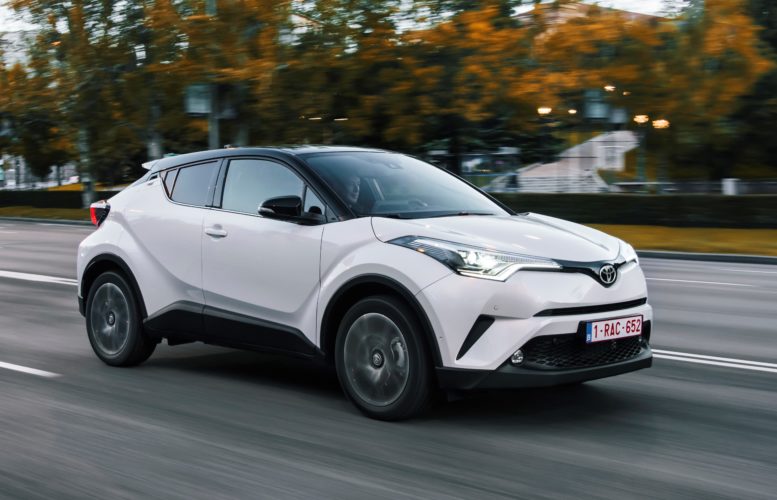
2016 Toyota C-HR driving characteristics are surprisingly good for this vehicle segment.
The feeling behind the steering wheel and driving characteristics is the next step to convince customers. Toyota C-HR satisfies with above the average precise steering and sensitively tuned suspension. C-HR also convinces with the stability, accuracy, and responsiveness. This car is really going exceptionally well.
Toyota C-HR is standing on large wheels, also because it needs to satisfy the high enough ground clearance demand in the SUV class. But still, they managed to keep a low center of gravity for better road holding.
Toyota claims that C-HR rides like a hatchback. They also say that it was sent to the track and it was competitive. Do we believe them? Yes, we do!
Toyota C-HR engines: hybrid, the absence of diesel

2016 Toyota C-HR hybrid engine, an alternative to diesel in terms of low fuel consumption.
You can not get a diesel engine in Toyota C-HR. But here is a hybrid option that can follow the low fuel consumption, even without that typical morning ruggedness known from modern diesel engines. Anyway, Toyota C-HR runs smoothly and quietly, even in the morning.
Toyota C-HR 1.8 hybrid e-CVT

2016 Toyota C-HR 1.8 hybrid e-CVT has a total system power of 122 hp.
Toyota C-HR features a hybrid system of the latest generation, which emits only 82 grams of CO2 / km, an achievement without competition in this segment. It combines the 1.8-liter gasoline engine VVT-i, which has a maximum power of 98 hp at 5,200 rpm, and two electric generators for an additional 72 hp and 163 Nm of torque. Total system power amounts to 122 hp.
The combined fuel consumption is only 3.6 – 3.9 l / 100 km. The new hybrid power unit that develops 122 hp power is not only more efficient and lighter than previous systems but also offers better performance.
Toyota C-HR 1.2-liter turbo

2016 Toyota C-HR with 1.2-liter turbo charged engine develops 116 hp.
Toyota C-HR is also available with a new 1.2-liter turbocharged engine, which was first presented in the Auris. The engine, which develops 116 hp and 185 Nm of torque, generates 125 g CO2 / km and has a combined fuel consumption of 5.5 l / 100 km.
It can be associated with a six-speed manual transmission or a continuously variable automatic transmission. Version with continuously variable automatic transmission CVT is available with front or all-wheel drive.
What about the new Toyota C-HR Price and Release Date?
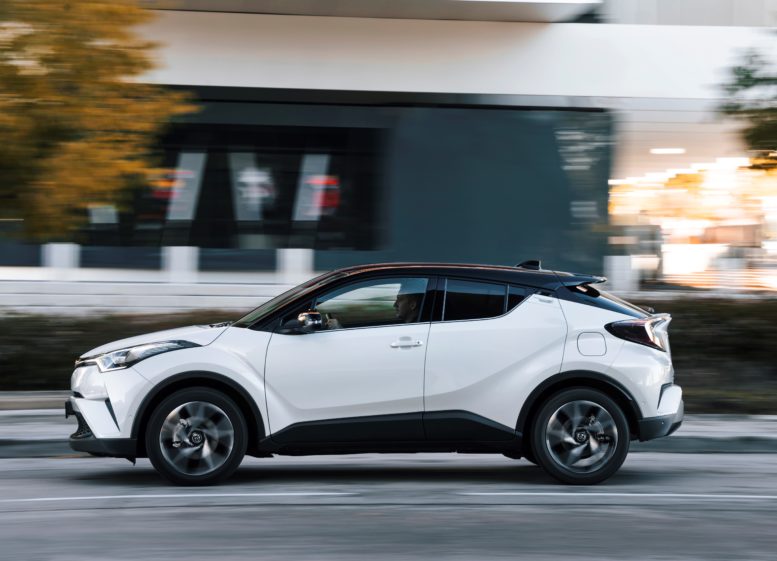
2016 Toyota C-HR price: 22,000 EUR for petrol or 27,500 EUR for the hybrid.
The price list for the entry model with 1,2-liter turbo engine starts from around 21,000 pounds in the UK and 22,000 EUR in Germany.
The hybrid version costs from around 26,500 pounds in the UK and from around 27,500 EUR in Germany.
Competitors and rivals

2016 Toyota C-HR competitors and rivals mostly come from Europe and Japan.
According to external dimensions, Toyota C-HR will have to deal with at least two successful compatriots. Nissan Qashqai is 6 centimeters longer and Nissan Juke is a competitor with a similar daring image, stronger engine options, and economical diesel.
We must not forget that the C-HR with a wide range of equipment, including a specially developed JBL audio system, for example, which includes an 8-channel 576-watt stereo amplifier and nine speakers, glances against premium competition. And in this area, we have a completely new Audi Q2 on the horizon.
- Honda HR-V (video comparison below)
- Kia Niro (video comparison below)
- Kia Sportage (video comparison below)
- Seat Ateca (video comparison below)
- Opel Mokka
- Nissan Juke
- Renault Captur
- Mazda CX-3 (video comparison below)
- Jeep Renegade (video comparison below)
- Peugeot 2008
- Audi Q2
- BMW X1 (video comparison below)
Toyota C-HR vs. Honda HR-V technical comparison
In our technical comparison between Toyota C-HR vs Honda HR-V we can see that Toyota is a bit longer and wider, with more room for front passengers. On the other hand, Honda HR-V is higher and with more ground clearance. It is also more generous with luggage volume and on average offers a bit better performance. All that for a lower base model price.
Mazda CX-3 vs. C-HR technical comparison
If you put Mazda CX-3 vs. Toyota C-HR side by side you will notice Toyota is a little longer, wider and higher. It also offers a bit more cargo volume and if you compare the basic models of both cars, Toyota is a bit faster and quicker. The advantage of Mazda CX-3 is a bigger luggage compartment when the rear seats are folded, you can also choose a diesel powertrain (Toyota does not offer one). Mazda is also faster and a lot quicker, when you choose the most powerful engine.
C-HR vs. Kia Niro technical comparison
C-HR vs. Seat Ateca technical comparison
These two share the same length and vehicle class, but probably nothing more. What to say? When choosing between Toyota C-HR vs. Seat Ateca, we suggest you look around the house. If you see a kid or two running around, then go for Ateca. If not, you will look better in C-HR. Simple as that.
Kia Sportage vs Toyota C-HR technical comparison
Almost no difference in base model price between Kia Sportage vs. Toyota C-HR. The story is probably the same as for the comparison above. Sportage for families, C-HR for singles.
Jeep Renegade vs. C-HR technical comparison
BMW X1 vs. Toyota C-HR technical comparison
Maybe you would think this comparison is not in place, but if you look closer, BMW X1 and Toyota C-HR have almost the same length. And they are both SUV’s. So why not. Interested in what the result of this comparison is? Watch the video above.
Below the line, it is clear that competition is here. Toyota C-HR will have to go to the tough battlefield. But based on everything written above, it is well armed and ready to fight.
2016 Toyota C-HR technical details
2016 Toyota C-HR technical details
Dimensions and weight:
- Length: 4,360 mm
- Width: 1,795 mm
- Height: 1,565 mm (1,555 mm hybrid)
- Wheelbase: 2,640 mm
- Drag coefficient: 0,32
- Weight: 1,320 – 1,460 kg
- Luggage compartment: 377 litres
- Fuel tank capacity: 50 litres.
- Ground clearance: n/a.
2016 Toyota C-HR luggage compartment: 377 litres.
Engine options:
1.2-liter Turbo FWD Manual
Displacement: 1,197 ccm. Max. power: 116 hp. Max. torque: 185 Nm @ 1500-4000 rpm.
Top speed: 190 km/h. Acceleration (0-100 km/h): 10,9 seconds.
Average fuel consumption: 5,5 – 6 liter / 100 km. CO2 emissions: 125 – 136 g / km.1.2-liter Turbo FWD Multidrive S
Displacement: 1,197 ccm. Max. power: 116 hp. Max. torque: 185 Nm @ 1500-4000 rpm.
Top speed: 185 km/h. Acceleration (0-100 km/h): 11,1 seconds.
Average fuel consumption: 5,9 liter / 100 km. CO2 emissions: 134 – 135 g / km.1.2-liter Turbo AWD Multidrive S
Displacement: 1,197 ccm. Max. power: 116 hp. Max. torque: 185 Nm @ 1500-4000 rpm.
Top speed: 180 km/h. Acceleration (0-100 km/h): 11,4 seconds.
Average fuel consumption: 6,3 liter / 100 km. CO2 emissions: 143 – 144 g / km.1.8-liter VVT-I HYBRID
Displacement: 1,798 ccm. Max. power: 122 hp. Max. torque: petrol engine 142 Nm @ 3600 rpm.
Top speed: 170 km/h. Acceleration (0-100 km/h): 11,0 seconds.
Average fuel consumption: 3.6 – 3.9 liter / 100 km. CO2 emissions: 82 – 87 g / km.
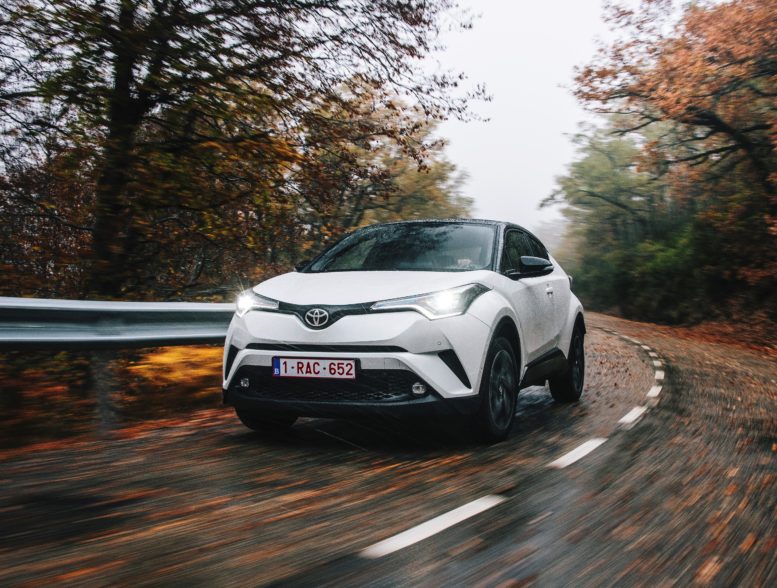
2016 Toyota C-HR fuel consumption: under 4 liters/100 km (hybrid) and around 6 liters/100 km (1.2-liter petrol version).
Image credit: Toyota
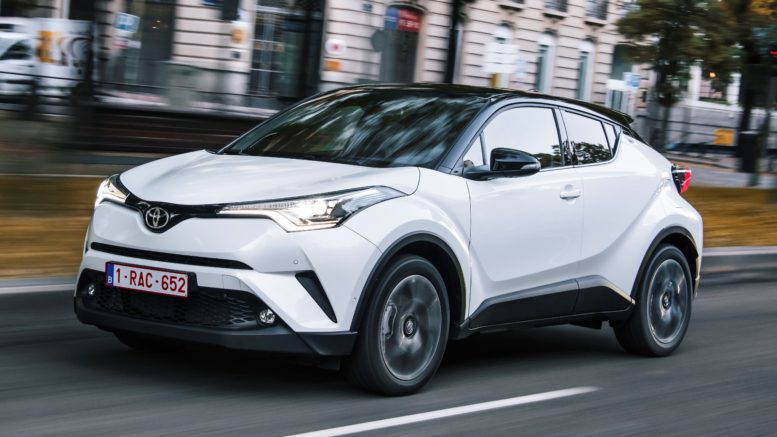
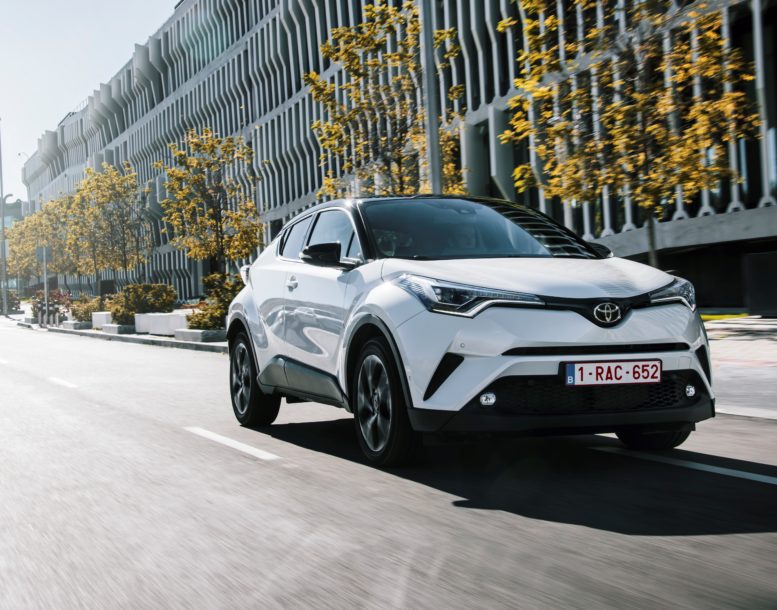


It is an awesome car and seeing a launch and doing good in other parts of the world. There is some news going on to launch it in my country and we are really waiting for this beauty.